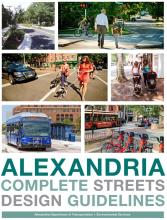Complete Streets Design Guidelines
Intent of the Guidelines

The intent of the Complete Streets Design Guidelines is to ensure that Alexandria's streets meet the needs of all users, including pedestrians, bicyclists, transit users, drivers, residents, workers, visitors, and business owners. The Guidelines are intended to clearly communicate expectations regarding the design of the City's public and private streets. The Guidelines are designed to be comprehensive, covering all aspects of street design. Where necessary, these Guidelines refer the reader to other City policies and design guides. The Guidelines were formed around the current best practices in street design in Alexandria, the metropolitan DC area, and around the world. As such, they are intended to evolve and adapt to incorporate new treatments and techniques as they are developed and proven. The Guidelines encourage tailoring designs to meet the needs relevant to each neighborhood context. These guidelines are therefore intended to be flexible and responsive to unique site circumstances. In all cases, street design will be subject to staff approval based on these design guidelines and professional judgment.
Street Types
The Guidelines present a set of street types that classify Alexandria's streets to incorporate street character and adjacent land uses—both existing, planned and desired. These guidelines provide a new classification system that will help guide future land development, street improvements and road design projects.
Download the full report or click below to go directly to the following chapters.
Audience
The Guidelines are a resource for City departments, design professionals, and private developers and their consultants. Though not intended as a primary audience, they may also serve as reference for elected officials, neighborhood groups, advocates, and interested residents.
Vision
Streets are vital to the health, mobility, and accessibility of Alexandria's residents, workers, and visitors. Alexandria aspires to have a comprehensive, integrated transportation network with design that allows safe and convenient travel for people of all ages and abilities, including children, older adults and individuals with disabilities. The network should accommodate all users, including pedestrians, bicyclists, transit users, and motorists and incorporate green infrastructure to enhance the city's environmental quality.
Guiding Principles
The vision is implemented through complete street design guidance that follows and advances five core principles:
ACCOMMODATE ALL MODES OF TRAVEL
Alexandria's streets should be safe and convenient for people walking, bicycling, taking transit and using motor vehicles. Projects that impact the public right-of-way will consider the characteristics of all modes of travel so that all users are safe and comfortable.
HEALTH AND SAFETY FOR ALL USERS
Street design in Alexandria should take into account the safety of all users, including children, older adults and individuals with disabilities with a particular emphasis on the protection of vulnerable road users. Alexandria's streets should encourage walking, bicycling and taking transit as safe, convenient modes of transportation that promote health and independence for all people. Street design will minimize impacts of traffic and strive to protect all users.
NEIGHBORHOOD AND ECONOMIC VITALITY
Alexandria is a city of great neighborhoods. Street design will help to support sustainable neighborhoods by providing more efficient multimodal access between destinations and by creating neighborhoods that attract people and strengthen local economies.
PLACEMAKING AND NEIGHBORHOOD CHARACTER
Streets represent the largest public resource by area in Alexandria. Their design and function should enhance the public realm and create multifunctional places that attract people and commerce. Street design should maintain, and in some cases accentuate, the history and identity of each neighborhood and commercial district while allowing for flexibility in design to strengthen the attributes that make these areas unique.
SUSTAINABLE DESIGN
Transportation projects should emphasize design techniques that reduce lifecycle costs and integrate green infrastructure to improve street tree health, treat stormwater runoff, and improve environmental quality.